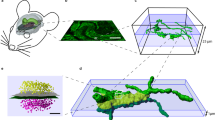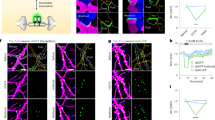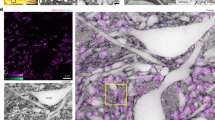Abstract
Elucidating the molecular organization of synapses is essential for understanding brain function and plasticity. Immunofluorescence, combined with various fluorescent probes, is a sensitive and versatile method for morphological studies. However, analysis of synaptic proteins in situ is limited by epitope-masking after tissue fixation. Furthermore, postsynaptic proteins (such as ionotropic receptors and scaffolding proteins) often require weaker fixation for optimal detection than most intracellular markers, thereby hindering simultaneous visualization of these molecules. We present three protocols, which are alternatives to perfusion fixation, to overcome these restrictions. Brief tissue fixation shortly after interruption of vital functions preserves morphology and antigenicity. Combined with specific neuronal markers, selective detection of γ-aminobutyric acid A (GABAA) receptors and the scaffolding protein gephyrin in relation to identified inhibitory presynaptic terminals in the rodent brain is feasible by confocal laser scanning microscopy. The most sophisticated of these protocols can be associated with electrophysiology for correlative studies of synapse structure and function. These protocols require 2–3 consecutive days for completion.
This is a preview of subscription content, access via your institution
Access options
Subscribe to this journal
Receive 12 print issues and online access
$259.00 per year
only $21.58 per issue
Buy this article
- Purchase on Springer Link
- Instant access to full article PDF
Prices may be subject to local taxes which are calculated during checkout



Similar content being viewed by others
References
Racz, B., Blanpied, T.A., Ehlers, M.D. & Weinberg, R.J. Lateral organization of endocytic machinery in dendritic spines. Nat. Neurosci. 7, 917–918 (2004).
Triller, A., Cluzeaud, F., Pfeiffer, F., Betz, H. & Korn, H. Distribution of glycine receptors at central synapses: an immunoelectron microscopy study. J. Cell Biol. 101, 683–688 (1985).
Somogyi, P. in Neural Mechanisms of Visual Perception (eds. Lam, D.K.T. & Gilbert, C.D.) 35–62 (Portfolio Publishing Co, Houston, 1989).
Lujan, R., Nusser, Z., Roberts, J.D., Shigemoto, R. & Somogyi, P. Perisynaptic location of metabotropic glutamate receptors mGluR1 and mGluR5 on dendrites and dendritic spines in the rat hippocampus. Eur. J. Neurosci. 8, 1488–1500 (1996).
Landis, D.M. Membrane and cytoplasmic structure at synaptic junctions in the mammalian central nervous system. J. Electr. Microsc. Tech. 10, 129–151 (1988).
Harlow, M.L., Ress, D., Stoschek, A., Marshall, R.M. & McMahan, U.J. The architecture of active zone material at the frog's neuromuscular junction. Nature 409, 479–484 (2001).
Dick, O. et al. The presynaptic active zone protein bassoon is essential for photoreceptor ribbon synapse formation in the retina. Neuron 37, 775–786 (2003).
Baron, M.K. et al. An architectural framework that may lie at the core of the postsynaptic density. Science 311, 531–535 (2006).
Ottersen, O.P. & Landsend, A.S. Organization of glutamate receptors at the synapse. Eur. J. Neurosci. 9, 2219–2224 (1997).
Cowan, W.M., Sudhof, T.C. & Stevens, C.F. Synapses (Johns Hopkins Univ. Press, Baltimore, 2001).
Phillips, G.W. & Bridgman, P.C. Immunoelectron microscopy of acetylcholine receptors and 43 kD protein after rapid freezing, freeze-substitution, and low-temperature embedding in Lowicryl K11M. J. Histochem. Cytochem. 39, 625–634 (1991).
Nusser, Z. et al. Immunocytochemical localization of the α1 and β2/3 subunits of the GABAA receptor in relation to specific GABAergic synapses in the dentate gyrus. Eur. J. Neurosci. 7, 630–646 (1995).
Kulik, A. et al. Compartment-dependent colocalization of Kir3.2-containing K+ channels and GABAB receptors in hippocampal pyramidal cells. J. Neurosci. 26, 4289–4297 (2006).
Hagiwara, A., Fukazawa, Y., Deguchi-Tawarada, M., Ohtsuka, T. & Shigemoto, R. Differential distribution of release-related proteins in the hippocampal CA3 area as revealed by freeze-fracture replica labeling. J. Comp. Neurol. 489, 195–216 (2005).
Rash, J.E., Yasumura, T. & Dudek, F.E. Ultrastructure, histological distribution, and freeze-fracture immunocytochemistry of gap junctions in rat brain and spinal cord. Cell Biol. Int. 22, 731–749 (1998).
Rash, J.E. et al. Ultrastructural localization of connexins (Cx36, Cx43, Cx45), glutamate receptors and aquaporin-4 in rodent olfactory mucosa, olfactory nerve and olfactory bulb. J. Neurocytol. 34, 307–341 (2005).
Wouterlood, F.G., Bockers, T.M. & Witter, M.P. Synaptic contacts between identified neurons visualized in the confocal laser scanning microscope. Neuroanatomical tracing combined with immunofluorescence detection of post-synaptic density proteins and target neuron-markers. J. Neurosci. Meth. 128, 129–142 (2003).
Koulen, P., Sassoè-Pognetto, M., Grünert, U. & Wässle, H. Selective clustering of GABAA and glycine receptors in the mammalian retina. J. Neurosci. 16, 2127–2140 (1996).
Fritschy, J.M., Weinmann, O., Wenzel, A. & Benke, D. Synapse-specific localization of NMDA- and GABAA-receptor subunits revealed by antigen-retrieval immunohistochemistry. J. Comp. Neurol. 390, 194–210 (1998).
Geiman, E.J., Zheng, W., Fritschy, J.M. & Alvarez, F.J. Glycine and GABAA receptor subunits on Renshaw cells: relationship with presynaptic neurotransmitters and postsynaptic gephyrin clusters. J. Comp. Neurol. 444, 275–289 (2002).
Sassoe-Pognetto, M., Wassle, H. & Grunert, U. Glycinergic synapses in the rod pathway of the rat retina: cone bipolar cells express the α1 subunit of the glycine receptor 14, 5131–5146 (1994).
Melone, M., Burette, A. & Weinberg, R.J. Light microscopic identification and immunocytochemical characterization of glutamatergic synapses in brain sections. J. Comp. Neurol. 492, 495–509 (2005).
Watanabe, M. et al. Selective scarcity of NMDA receptor channel subunits in the stratum lucidum (mossy fibre-recipient layer) of the mouse hippocampal CA3 subfield. Eur. J. Neurosci. 10, 478–487 (1998).
Nagy, G.G., Watanabe, M., Fukaya, M. & Todd, A.J. Synaptic distribution of the NR1, NR2A and NR2B subunits of the N-methyl-D-aspartate receptor in the rat lumbar spinal cord revealed with an antigen-unmasking technique. Eur. J. Neurosci. 20, 3301–3312 (2004).
Barnard, E.A. et al. International Union of Pharmacology. XV. Subtypes of γ-aminobutyric acidA receptors: classification on the basis of subunit structure and function. Pharmacol. Rev. 50, 291–313 (1998).
Sieghart, W. & Ernst, M. Heterogeneity of GABAA receptors: revived interest in the development of subtype-selective drugs. Curr. Med. Chem. 5, 217–242 (2005).
Colquhoun, D. & Sivilotti, L.G. Function and structure in glycine receptors and some of their relatives. Trends Neurosci. 27, 337–344 (2004).
Lynch, J.W. Molecular structure and function of the glycine receptor chloride channel. Physiol. Rev. 84, 1051–1095 (2004).
Kneussel, M. & Betz, H. Receptors, gephyrin and gephyrin-associated proteins: novel insights into the assembly of inhibitory postsynaptic membrane specializations. J. Physiol. 525, 1–9 (2000).
Sassoè-Pognetto, M. & Fritschy, J.M. Gephyrin, a major postsynaptic protein of GABAergic synapses. Eur. J. Neurosci. 7, 2205–2210 (2000).
Fritschy, J.M. & Mohler, H. GABAA-receptor heterogeneity in the adult rat brain: differential regional and cellular distribution of seven major subunits. J. Comp. Neurol. 359, 154–194 (1995).
Panzanelli, P., Perazzini, A.Z., Fritschy, J.M. & Sassoè-Pognetto, M. Heterogeneity of γ-aminobutyric acid type A receptors in mitral and tufted cells of the rat main olfactory bulb. J. Comp. Neurol. 484, 121–131 (2005).
Giustetto, M., Kirsch, J., Fritschy, J.M., Cantino, D. & Sassoè-Pognetto, M. Localisation of the clustering protein gephyrin at GABAergic synapses in the main olfactory bulb of the rat. J. Comp. Neurol. 395, 231–244 (1998).
Triller, A., Cluzeaud, F. & Korn, H. γ-Aminobutyric acid-containing terminals can be apposed to glycine receptors at central synapses. J. Cell Biol. 104, 947–956 (1987).
Sassoè-Pognetto, M. et al. Colocalization of gephyrin and GABAA-receptor subunits in the rat retina. J. Comp. Neurol. 357, 1–14 (1995).
Sassoè-Pognetto, M., Panzanelli, P., Sieghart, W. & Fritschy, J.M. Co-localization of multiple GABAA receptor subtypes with gephyrin at postsynaptic sites. J. Comp. Neurol. 420, 481–498 (2000).
Schweizer, C. et al. The γ2 subunit of GABAA receptors is required for maintenance of receptors at mature synapses. Mol. Cell. Neurosci. 24, 442–450 (2003).
Koksma, J.J., Fritschy, J.M., Mack, V., Van Kesteren, R.E. & Brussaard, A.B. Differential GABAA receptor clustering determines GABA synapse plasticity in rat oxytocin neurons around parturition and the onset of lactation. Mol. Cell. Neurosci. 28, 128–140 (2005).
Lorenzo, L.E., Barbe, A., Portalier, P., Fritschy, J.M. & Bras, H. Differential expression of GABAA and glycine receptors in ALS-resistant vs. ALS-vulnerable motoneurons: possible implications for selective vulnerability of motoneurons. Eur. J. Neurosci. 23, 3161–3170 (2006).
Fagiolini, M. et al. Specific GABAA circuits for visual cortical plasticity. Science 303, 1681–1683 (2004).
Knuesel, I., Zuellig, R.A., Schaub, M.C. & Fritschy, J.M. Alterations in dystrophin and utrophin expression parallel the reorganization of GABAergic synapses in a mouse model of temporal lobe epilepsy. Eur. J. Neurosci. 13, 1113–1124 (2001).
Knuesel, I. et al. Altered synaptic clustering of GABAA-receptors in mice lacking dystrophin (mdx mice). Eur. J. Neurosci. 11, 4457–4462 (1999).
Acknowledgements
The authors wish to thank C. Sidler for excellent technical assistance and L. Viltono for providing Figure 2g. The work was supported by a Swiss National Science Foundation grant (3100A0-108260) to J.-M.F. and an Italian MIUR grant (PRIN 2005059123 002) to M.S.-P.
Author information
Authors and Affiliations
Corresponding author
Ethics declarations
Competing interests
The authors declare no competing financial interests.
Rights and permissions
About this article
Cite this article
Schneider Gasser, E., Straub, C., Panzanelli, P. et al. Immunofluorescence in brain sections: simultaneous detection of presynaptic and postsynaptic proteins in identified neurons. Nat Protoc 1, 1887–1897 (2006). https://doi.org/10.1038/nprot.2006.265
Published:
Issue Date:
DOI: https://doi.org/10.1038/nprot.2006.265
This article is cited by
-
A combinatorial code of neurexin-3 alternative splicing controls inhibitory synapses via a trans-synaptic dystroglycan signaling loop
Nature Communications (2023)
-
Subcellular localization of D2 receptors in the murine substantia nigra
Brain Structure and Function (2022)
-
Cerebellar molecular layer interneurons are dispensable for cued and contextual fear conditioning
Scientific Reports (2020)
-
Enhancing neuronal chloride extrusion rescues α2/α3 GABAA-mediated analgesia in neuropathic pain
Nature Communications (2020)
-
LncRNA ODIR1 inhibits osteogenic differentiation of hUC-MSCs through the FBXO25/H2BK120ub/H3K4me3/OSX axis
Cell Death & Disease (2019)
Comments
By submitting a comment you agree to abide by our Terms and Community Guidelines. If you find something abusive or that does not comply with our terms or guidelines please flag it as inappropriate.



